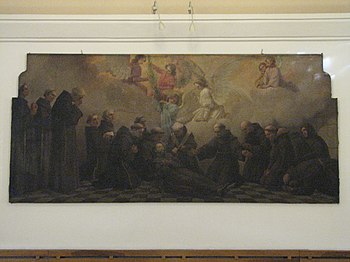Transitus

In Western Christianity, the Transitus (translation from Ecclesiastical Latin: crossing) refers to "the time of passage through death to life".[1]
The Christian theologian German Martinez writes that:[2]
The idea of death in the Latin transitus (transition, passing over) represents a unique Christian terminology linked to the paschal mystery. It consecrates the passage of the dying to eternal life. Offering the sacrifice of his or her personal life, the believer shares in the paschal transitus of Christ himself.[2]
Observance
[edit]With reference to various Christian religious orders, liturgies for observing the Transitus may differ.
Franciscans in general observe the Transitus of Saint Francis of Assisi on October 3, the eve of his feast.[3] However, there is not a single liturgy for the Transitus among the different branches, and "therefore many expressions have developed" for this service.[3]
In the Methodist Order of Saint Luke, lessons from Psalm 23, Romans 1:4–8, and 1 Peter 1:3 are read; consequently anointing with holy anointing oil takes place.[4]
See also
[edit]References
[edit]- ^ The Book of Offices and Services (Fourth ed.). Order of Saint Luke. 2012. p. 81. ISBN 1478391022.
- ^ a b Martinez, German (2003). Signs of Freedom: Theology of the Christian Sacraments. Paulist Press. p. 238. ISBN 9780809141609.
- ^ a b Kent, Jim (2015). "Transitus – What is it?". Conventual Franciscan Friars. Retrieved 4 December 2015.
Transitus is the annual celebration by Franciscans throughout the world of the passing of St. Francis from this life to life with God. It is celebrated the night of October 3, the eve of his feast day. The word "transitus" comes from the Latin, meaning passage or crossing. There is no one ritual for Transitus, and therefore many expressions have developed for this liturgy. Certain prayers or writings of St. Francis and accounts from his early biographers are common.
- ^ Duck, Ruth C. (2013). Worship for the Whole People of God: Vital Worship for the 21st Century. Westminster John Knox Press. p. 229. ISBN 9780664234270.
The Order of Saint Luke (an ecumenical order within the United Methodist Church) has published "A Service for the Time of Passage through Death to Life for Brothers and Sisters in The Order of St. Luke: The Transitus." It moves through greeting and the reading of Psalm 23; Romans 1:4-8; and 1 Peter 1:3. Then a ritual of anointing follows: The sign of the cross may be made on the forehead of the person with the words: 'Remember that you were sealed by the Holy Spirit at your baptism and marked as Christ's own forever.'" Prayers and possibly the Eucharist follow. The service concludes with singing the Canticle of Simeon ("Lord, you are dismissing your servant in peace, according to your word," Luke 2:29) and a benediction.
